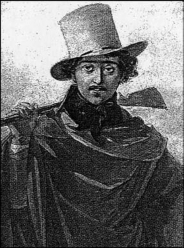- SZÉCHENYI
- HUNGARY (see also List of Individuals)\
 21.9.1791 Wien/A - 8.4.1860 Döbling-Wien/A\István Széchenyi passed his youth with battles in the Austrian army until the end of the Napoleon Wars. From 1815 to 1821 he visited a number of European countries and got acquainted with their institutions. A second scientific tour brought him to the centers of trade, a knowledge he applied to the needs of his country. When back in France in 1825, the Canal de Midi attracted him and he thought whether the Danube and the Tisza Rivers could be similarly regulated. In the same year, the Hungarian Academy of Sciences was founded with a large sum sponsored by Széchenyi. Shortly later, he was able to open the Danube River for navigation from Buda to the Black Sea. Széchenyi convinced himself of the practicability by a voyage to Constantinople, today's Istanbul in Turkey. In 1833 the Danube Navigation Committee was founded and river works were completed within ten years. Széchenyi also started with steam boats on Rivers Tisza and Danube and on Lake Balaton in the 1840s.\Up until the early 1830s, the large rivers of Hungary had not received any restoration. During low discharge navigation was impossible whereas large floods led to significant loss of life and goods, combined with damages to agriculture because of poorly drained soils. Accordingly, people left the Teisz plains. In 1833, Count Széchenyi undertook as Minister of traffic a memorable passage on the River to obtain an overlook of the site conditions. Based on his proposal, the flood protection works were initiated three years later and lasted for nearly hundred years. Dikes of a total length of 3,500 km were erected, and the drainage canals were 11,000 km long. The total length of the Tisza River was reduced by some 450 km to improve the flow conditions during floods. Count Széchenyi was a leading personality of the Hungarian reform movement in the first part of the 19th century, and later took interest in the political development of his country. His contemporaries hailed him as The greatest Hungarian during lifetime because of his contributions in social reformation, politics and poetry. The sudden death of a close friend and political problems led him in a moment of despair to take his life.\Anonymous (2003). Széchenyi, István. Magyar Nagylexikon 16: 549-551. Kiadó: Budapest. PLampl, H. (1933). Graf Stefan Széchenyi - Erinnerungsfahrt. Vízügyi Közlemények 15(2): 7-36 (in Hungarian). PPalfai, I. (1991). Széchenyi and the regulation of River Tisza. Vízügyi Közlemények 73(2): 101-110 (in Hungarian). PSzéchenyi, I. (1858). Hunnia. Heckenast: Pesten (in Hungarian).
21.9.1791 Wien/A - 8.4.1860 Döbling-Wien/A\István Széchenyi passed his youth with battles in the Austrian army until the end of the Napoleon Wars. From 1815 to 1821 he visited a number of European countries and got acquainted with their institutions. A second scientific tour brought him to the centers of trade, a knowledge he applied to the needs of his country. When back in France in 1825, the Canal de Midi attracted him and he thought whether the Danube and the Tisza Rivers could be similarly regulated. In the same year, the Hungarian Academy of Sciences was founded with a large sum sponsored by Széchenyi. Shortly later, he was able to open the Danube River for navigation from Buda to the Black Sea. Széchenyi convinced himself of the practicability by a voyage to Constantinople, today's Istanbul in Turkey. In 1833 the Danube Navigation Committee was founded and river works were completed within ten years. Széchenyi also started with steam boats on Rivers Tisza and Danube and on Lake Balaton in the 1840s.\Up until the early 1830s, the large rivers of Hungary had not received any restoration. During low discharge navigation was impossible whereas large floods led to significant loss of life and goods, combined with damages to agriculture because of poorly drained soils. Accordingly, people left the Teisz plains. In 1833, Count Széchenyi undertook as Minister of traffic a memorable passage on the River to obtain an overlook of the site conditions. Based on his proposal, the flood protection works were initiated three years later and lasted for nearly hundred years. Dikes of a total length of 3,500 km were erected, and the drainage canals were 11,000 km long. The total length of the Tisza River was reduced by some 450 km to improve the flow conditions during floods. Count Széchenyi was a leading personality of the Hungarian reform movement in the first part of the 19th century, and later took interest in the political development of his country. His contemporaries hailed him as The greatest Hungarian during lifetime because of his contributions in social reformation, politics and poetry. The sudden death of a close friend and political problems led him in a moment of despair to take his life.\Anonymous (2003). Széchenyi, István. Magyar Nagylexikon 16: 549-551. Kiadó: Budapest. PLampl, H. (1933). Graf Stefan Széchenyi - Erinnerungsfahrt. Vízügyi Közlemények 15(2): 7-36 (in Hungarian). PPalfai, I. (1991). Széchenyi and the regulation of River Tisza. Vízügyi Közlemények 73(2): 101-110 (in Hungarian). PSzéchenyi, I. (1858). Hunnia. Heckenast: Pesten (in Hungarian).
Hydraulicians in Europe 1800-2000 . 2013.
